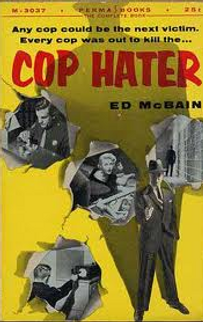
Cop Hater
Ed McBain

The Hound's book of the year for 1956, is Ed McBain’s first 87th Precinct novel. The series went on to have a profound effect on crime fiction, influencing Maj Sjöwall and Per Wahlöö, Aaron Elkins and Lawrence Block, among many other authors. And when the US television series Hill Street Blues first aired, the French press billed it, “Ed McBain comes to television!”
When Detective Reardon is found dead, motive is a big question mark. But when his partner becomes victim number two, it looks like open-and-shut grudge killings. That is, until a third detective buys it.
As the novel opens, police detective Mike Reardon is shot while on his way to work at the 87th. Because he’s a cop, the case is pursued vigourously right away. Detective Steve Carella and his partner Hank Bush are called to the scene and immediately get to work. They find out the kind of gun used in the murder (a .45 calibre gun) and take that as their starting point. They’ve got some leads at first but they don’t get very far. Then, David Foster, another 87th Precinct cop and Reardon’s partner, is shot while on his way home from his shift. Now it looks as though someone’s got a vendetta against these
two cops. So Carella and Bush look into all the cases that Reardon and Foster had to see who might use a .45 calibre gun and who might be willing to go after them. Each lead they get though seems to fade away as all of their suspects can account for themselves. Then, there’s another cop murder – this time of a detective who didn’t work cases with Reardon and Foster. Now it looks as though the cop killer is a maniac who wants to murder detectives.
In the meantime, Carella has other problems. The cops’ murders have made big news, and a reporter named Savage wants to get as many headlines as he can. He pursues a line of his own, despite Carella’s telling him to let the police solve the case, and for his trouble gets yet another cop wounded. As the case wears on, Carella and the team get little leads here and there, but they don’t know whether the killer is a gang member, a drug dealer with a personal grudge or a psychopath who wants to murder cops. The only problem with that last theory is that none of the victims was in uniform when he was killed. That means the killer had to know the detectives and that makes things all the worse.
McBain gives readers an “inside look” at life in a police precinct too. There are meetings with Carella’s boss Lieutenant Byrnes, there are other cases the police work, and there’s the routine of interrogation, precinct meetings and so on.
We also see the camaraderie and bantering of police work. For instance, when Reardon’s body is discovered, the Homicide cops who are first called to the scene do the preliminary work while they wait for the detectives. There’s also a dark sense of humour woven through the novel and the reader gets the strong impression that this dark humour is one way in which these cops cope with what they have to see and with the frightening reality that someone may be out there targeting them.
Despite the humour though this isn’t a light novel. Many people have classified this series as noir, and I can see why. Carella is under no illusions about what the city in which the precinct is located is like. Several of the characters are “down and out,” and readers get the feeling that no matter what Carella and the rest of the 87th Precinct do, crime’s going to go on anyway and the criminals they catch aren’t going to change their ways.
A heat wave has struck the city and since this story was written before air conditioning was common, most of the characters suffer greatly in the heat. That includes the police. The heat wave continues throughout the novel and makes everyone miserable. It adds a level of tension to the story and makes it clear why there is often more crime during a heat wave than there is when the weather is cooler.
The first novel of a groundbreaking series, Cop Hater shows the teamwork and camaraderie of police work. It’s a sad story despite the dark humour, and it shows the “down and out” part of city life. It’s gritty, too, without being either really brutal or gratuitous, and it gives a clear picture of what being a big city cop is like.
About Ed McBain:
Ed McBain is a pseudonym of Evan Hunter, who was born and raised as Salvatore Lombino in New York City, living in East Harlem until the age of 12, at which point his family moved to the Bronx. He attended Olinville Junior High School, then Evander Childs High School, before winning an Art Students League scholarship. Later, he was admitted as an art student at Cooper Union.
Hunter served in the Navy in World War II, writing several short stories while serving aboard a destroyer in the Pacific. However, none of these stories were published until after he had established himself as an author in the 1950s.
After the war, Hunter returned to New York and studied at Hunter College, majoring in English, with minors in dramatics and education. He published a weekly column in the Hunter College newspaper as "S.A. Lombino".
While looking to start a career as a writer, Hunter took a variety of jobs, including 17 days as a teacher at Bronx Vocational High School in September 1950. This experience would later form the basis for his 1954 novel The Blackboard Jungle.



